Ed was not able to recover the blog entries for our trip to Greece this year so I'm rewriting it. He did recover the photos. I hope I remember everything important. 😁
June 3, 2024 Kalo Taxidi / Bon Voyage!
Leaving Athens on a jet plane headed for Toronto and home after a great trip.
June 2, 2024 Arrival in Athens: National Archaeological Museum
Today is our last full day of our trip to Greece. We arrived early in the morning on the overnight ferry from Crete. After a short and quick bus ride to the hotel to drop off our luggage and eat breakfast, we head off on a walking tour of Athens.
The ferry.
We saw the changing of the guard on our second day in Greece. Today we caught the end of the changing of the guards and noticed the uniform was different.
The University of Athens.
A closer view of the statues at the University of Athens.
Walking a bit further we take the metro to go the National Archeological Museum, which is the largest museum in Greece. Here we meet our guide from the first day of our trip. We've been to a lot of museum on our trip so it's really nice to have a guide that is excited about the museum (or maybe she's just good at enthusiasm). Either way it makes the museum a lot more interesting. I still have trouble imaging the tools are required to make the beautiful pieces of art we have seen. I think museums should include the tools not just the art in their displays.
June 1, 2024 Chania - Overnight Ferry to Athens
Today is pretty much a free day as they ferry to Athens doesn't leave till later in the evening. The timing of check out and bag storage kink of messes up the day so Ed and I decide to wander around town away from the main tourist area (the port). There are cheese shops, fish markets, shoe stores, clothing stores, coffee shops and lots of non-tourists --- everything you would expect in a town.
This artist brings sand with him to build sand sculptures on the sidewalk.
We're on the ferry leaving port.
May 31, 2024 Chania: Walking Tour
We're meeting up with a local guide later this afternoon to visit a museum and then take a walking tour of Chania. This morning our main guide is taking us on a walking tour to Chania to visit sites we won't see this afternoon.
First stop is the Maritime Museum of Crete. The museum is in what was originally a covered wet dock where boats were built or repaired.
Another view of the museum.
The narrow streets around the harbour are filled with shops and restaurants.
Looking across the harbour at the colourful buildings.
The lighthouse at the entrance to the harbour.
More narrow streets. A lot of the buildings have been renovated but apparently not this one.
We meet up with our local guide. First stop is Eleftherios Venizelos House. Eleftherious Kyiakou Venizelos was a very important person in Greece, in fact the Athens airport is named after him. He was a Gretan Greek statesman and prominent leader of the Greek national liberation movement. He is noted for his contribution to the expansion of Greece and promotion of liberal-democratic policies.
Our next stop is the new Archaeological Museum that was built in 2022. The building itself was interesting and so were the contents. The museum contains a substantial collection of Minoan and Roman artifacts excavated from around the city of Chania and the surrounding regional unit.
The local guide brought us back to the harbour area for a tour. This is the Talos Square Fountain. We spend some time wandering the narrow streets of the harbour area.
May 30, 2024 Iraklion - Rethymnon - Chania
The people of Iraklion were celebrating late last night. Ed and my room was on the back of the hotel but I could still hear the horns honking, singing and music. Greece had won an important soccer match. Ed managed to sleep through the whole thing --- the noise started around 1am.
First stop today is the Archeological Museum in Iraklion. The museum is oldest museum in Greece and is known for its unique Minoan collection.
First stop on the way to Chania is Rethymnon. The old town here still retains its original aristocratic appearance, with
buildings dating back to the 16th century as well as Byzantine and Hellenistic-Roman remains and a small Venetian Harbour
The lighthouse in Rethymnon.
Souda Bay War Cemetary is a military cemetery administered by the Commonwealth War Graves Commission at Souda Crete. Soliers from both the 1st and 2nd World Wars are burried here, including a few from Canada.
Fields of grape the way we are use to seeing them.
The monastery of Agia Triada, originally built in the 17th century. The monastery has had quite the history --- it was burned down by the Ottomans, served as a seminary, a hospital and headquarters for insurgents and used as a supply depot by both the Greeks and later the Germans. Today it is one of the few monasteries in Crete
where monastic life is practiced. The monastery is engaged in organic farming and produces exquisite wine, raki, olive oil, honey, vinegar and olive soaps.
The harbour in Chania. Many years ago, the curved shaped buildings were wet docks for building and repairing boats.
We walked the breakwater to the old lighthouse.
The lighthouse at sunset.
May 29, 2024 Iraklion: Knossos & Lassithi Plateau
This morning we drive to Knossos where our local guide showed us the ancient palace of King Minos. It was first built around 1900 BCE. In 1700 BCE it was destroyed by an earthquake and rebuilt to a grader and more sophisticated design. The city of Knossos consisted of an immense palace, residences of officials and priests, the homes of ordinary people and burial grounds. The palace, which covered an area of 22,000 sq m consisted of royal domestic quarters, public reception rooms, shrines, workshops, treasures and storerooms around a central court. Knossos was excated by Arhur Evans between 1900 and 1930. Much of what we saw has been rebuilt.
In the village of Krasi is this 2400 year old Plane Tree on the island of Crete. We also passed a store with this interesting display outside, plus a number of interesting plants.
We stopped at the Moni Vidianis Monastery which was built in 1854 probably on the fundaments of an older monastery. Today, the monastery is serving as a men monastery and is dedicated to Zoodochos Pigi which translates to "Life-Giving Spring". The spring is symbolized by a small fountain outside the monastery.
This donkey was hanging out by the side of the road.
Ambelos Windmills at Selli
Looking down the valley by the Windmills.
Before dinner, Ed and I took a walk around Iraklion. We found the Morosini Fountain (Lion's Fountain) in the Eleftheriou Venizelou Square (Lions Square). The fountain dates back to the Venetian era. Dolphin Statue down by the harbour.
There is a 2.5 km long breakwater that leads to a lighthouse.
Along the breakwater are some really interesting murals. This is one of our favourites.
May 28, 2024 Santorini and Ferry to Iraklion, Crete
The fast ferry to Crete didn't depart till the afternoon so we had some time to wander around near the hotel.
The beach.
Unfortunately, you can't see it in the photo but there is road that winds it's way up the hill leading to an archeological site.
Looking down at the ferry harbour in Santorini.
The fast ferry to Crete was comfortable and quick, but again there was no deck on which to enjoy being at sea. We arrived in Iraklion Crete late in the afternoon. We checked into the hotel then headed off to dinner. This is the view of the harbour from the restaurant.
May 27, 2024 Santorini
Enjoying breakfast by pool at our hotel in Santorini.
This morning we drive to Oia. and wander around this beautiful town.
While we wandered around you saw a number of people getting professional photos taken. Apparently, people come to Santorini to have wedding photos taken even if they have gotten married in another country.
Some of our motley crew.
A couple of cruise ships are in the harbour, so town feels really crowded to us. We duck down a side street and start walking towards the water.
Along our walk we found the Holy Church of Panagia "soumela" and Agios Georgios "Methystis", at least according to the sign. This building was built into the volcanic rock.
Continuing to follow the road down to water we see a lot of parked vehicles. This is what we see when we round the final bend.
Looking down at the small harbour.
You can hire a horse to take you up the hill if you don't want to walk. Ed and I walked --- it wasn't that bad.
Santorini also has old windmills --- some of them are modern and built as accommodations for tourists.
Instead of a hike we went to a Artemis Karamolegos winery for a wine tasting. The wines were surprising good and one of them is available at the LCBO.
May 26, 2024 Santorini Akrotiri & Island tour
Today is the first time we see rain. The island really needs rain but this rainfall is too light and short to do a lot of good. Our first stop of the day is the Museum of Prehistoric Thera. The finds that are on display in the museum come from the various excavations that were carried out on the island, such as the settlements of Akrotiri and Potamos as well as some object that were discovered by chance and handed over.
Akrotiri is the site of a Cycladic Bronze Age settlement. The settlement was destroyed in the Theran eruption sometime in the 16th century BCE and buried in volcanic ash, which preserved the reaimns of fine frescoes and many objects and artworks. Akrotiri has been excavated since 1967. This site is considered Greece's Pompeii. The above is a wall mural.
Many of the pieces of pottery are in excellent condition as they were preserved and protected by the volcanic ash.
The Akrotiri Ship Fresco is a miniature frieze almost four metres long which was discovered in 1972. The detail in the frieze is incredible.
A couple of views of the Santorini as we drive across the island to Akrotiri.
We stopped in a small town for lunch. Some interesting pieces of art.
The flower of the caper plant.
A structure was built over the the excavation site of Akrotiri to protect it from the weather.
A few pots have been left in situ.
May 25, 2024 Mykonos and the ferry to Santorini
We took a "fast ferry" from Mykonos to Santorini. The fast ferry is definitely faster than the regular ferry but in my opinion not as enjoyable. All the seating is indoors, reminiscent of a airplane but a lot more comfortable. I missed feeling the sea breeze.
Looking down at the ferry dock in Santorini. There are steeps cliffs on this side of the island.
Our hotel was on the opposite side of Santorini from the ferry dock. The section we were in didn't have cliffs, just black rock beaches. Santorini is a volcanic island so the beach is actually volcanic rock. The hotel is quite close to the airport so we got a good view when the planes were landing.
 Nearing the end of the beach.
Nearing the end of the beach.
Looking the opposite directions down the beach. The beach is made up of sharp little rocks ---- you don't want to go barefoot on it.
We are driving across the island to the city of Fira. It's a cute little white city built on a hill.
People disembarking from cruise ships can opt to take a cable car to the top.

Magic hour. The sun is getting ready to set and everything basks in a golden light.
The sun has set and all the lights are on.
Bougainvillea comes in lots of colours.
May 24, 2024 Mykonos and Delos
One of the narrow streets on Mykonos.
A boat takes us to the tiny sacred island of Delos (40 minutes away). Delos gives the whole group of islands
surrounding it their name, the Cyclades -- so named because they form a circle (kyklos) around Delos. For nearly 1,000 years this
sanctuary was the political and religious centre of the Aegean. Leto, pregnant by Zeus, gave birth to the twins Apollo and Artemis on
Delos. In the 18th century BCE, the annual Delia Festival was established on the island to celebrate the birth of Apollo. Delos was
populated during its height in Hellenistic times with wealthy merchants, mariners and bankers from as far away as Egypt and Syria.
One of many mosaic floors at Delos
What is left of unground water storage tanks.
Lots of cats on Delos, the museum employees take care of the cats.
The terrace of Lions was erected and dedicated to Apollo by the people of Naxos just before 600 BCE. The terrace consisted of a row of nine to twelve marble carved lions that faced eastward. The lions with their mouths open as if roaring or snarling, were both meant to guard to guard the sanctuaries and inspire a feeling of divine fear among the worshippers. Today only five of the original lions remain.
Only a small portion of the town has been excavated. Test holes have been made than indicated there are a lot more ruins to be found.
Back in Mykonos
Someone must have been cleaning fish.
One of many churches, a lot of the churches are family churches.
The main harbour in Mykonos as the sun sets and the ships turn their lights on.
May 23, 2024 Off to the Islands
 This morning we were up really early, so early we were able to see the sun rise from the hotel's roof restaurant. Breakfast was not available yet but they did have coffee and snacks for us. We left the hotel around 6:15 am to drive to the ferry terminal to catch the ferry to Mykonos. It was the "regular" ferry so we were able to sit out on the deck and enjoy being on the water.
This morning we were up really early, so early we were able to see the sun rise from the hotel's roof restaurant. Breakfast was not available yet but they did have coffee and snacks for us. We left the hotel around 6:15 am to drive to the ferry terminal to catch the ferry to Mykonos. It was the "regular" ferry so we were able to sit out on the deck and enjoy being on the water.
The ferry sailed passed several islands, plus it stopped at Syros and Tinos before arriving in Mykonos.
The island of Syros.A closer look at the town on Syros. The island of Tinos. Our main guide actually lives on Tino.
Mykonos is part of the Cyclades lying between Tinos, Syros, Paros and Naxos. The island has an area of 85.5 square kilometres and rises to an elevation of 341 metres at it's highest point. There are approximately 11,000 inhabitants most of home live in Chora (the city where we stayed). You can venture into the labyrinth of dazzling, white-washed streets to the many churches, tavernas, or shops selling artisan crafts. The labyrinth design was intended
to confuse the pirates who plagued Mykonos in the eighteenth and 19th centuries. The whitewashed houses conceal dozens of little
churches, shrines and chapels.
A string of windmills that once harnessed the breezes of days gone by.
May 22, 2024 Athens
Everywhere you go in Athens you see graffiti. The subway trains were well decorated.
Our first tour of the day was the Agora, the commercial, assembly or residential gathering place of the ancient Greeks. This building is the Temple of Hephaestus which was dedicated to Hephaestus, the Greek god of blacksmithing and Athena, the goddess of pottery and crafting. .
This guy was wandering around the Agora.
A view of the Acropolis from the Agora.
 Temple of Hephaestus from a distance.
Temple of Hephaestus from a distance.
We had a bit of free time after our visit to the Agora so Ed and I went for a walk in a residential area near the Acropolis. One of the buildings had this interesting fountain out front. Almost every balcony were covered in plants and bougainvillea was on many of the buildings.
I'm sure Modern technology is making the rebuild of the Parthenon much easier than the original build.
A view of the city from the Acropolis.
The Odeon of Herodes Atticus is a stone Roman theatre structure located on the southwest slope of the Acropolis. The building was completed in 161 BCE and then renovated in 1950. The theatre is still being used and they were getting it ready for a show.
The entrance to the Acropolis seemed busy to us, apparently it can get a lot busier.
A few photos of the Parthenon. The Parthenon is a temple, dedicated to Athena, goddess of wisdom and war, and it stands as a monumnet to democracy that has withstood the trials and tribulations of history.
The temple of Athena Polias is an ancient Greek Ionic temple on the north side of the Acropolis which was primarily dedicated to the goddess Athena. The original statues were being damaged by acid rain so they were removed and put on display in to the Acropolis museum and replicas put in place at the temple.
One of the entrances / exits into the Acropolis.
When the Acropolis museum was being built ruins were found. You can walk around under part of the museum or you can see the ruins through windows in the part of the first floor of the museum.
May 21, 2024 Kalambaka - Thermopylae - Athens
Before we boarded the bus to drive back to Athens, Ed and I went for a walk around the hotel in Kalambaka.
We stopped in Thermopylae where the battle of Thermopylae was fought in 480 BCE between the Achaemenid Persian Empire under Xerxes I and an alliance of Greek city-states led by Sparta under Leonidas. Lasting over the course of three days, it was oneof the most prominent battles of both the second Persian invasion of Greece and the wider Greco Persian Wars in history. There was a simple monument and a information centre. The information centre showed a very good film explaining the battle.
May 20, 2024 Delphi - Kalambaka - Monasteries of Meteora
Scenery on the way to Kalambaka
I'm not sure if this is grouse or a relative, but it looked a lot like the yellow plants we saw in Scotland last spring.
Interesting cement truck painted like the flag of Greece.
The Monasteries of Meteora, built upon rocks that rise vertically from the plains
below. These "Rocks of the Air" are visible for miles around and are crowned with old monasteries that cling to their summits. The Meteora is one of the largest and most important complexes of Eastern Orthodox monasteries and is second only to Mount Athos.
The monasteries are built on natural sandstone rock pillars at the northwestern edge of the Plain of Thessaly.
At one time there were 24 monasteries in Meteora. Today only 6 monasteries are active, 2 of them are convents with nuns and the other 4 are male monasteries with monks.
The Varlaam Monastery.
The flag of Greece and the flag of the Greek Orthodox Church.
The ceiling in a new part of the monastery --- no picture taking in the original sections of the monastery.
Looking across the valley is the Roussanou convent which is home to a group of nuns. This is the 2nd monastery that we visited.

Another view of Roussanou Monastery (convent).
Our local guide suggested a downhill walk through a lovely wooded area instead of walking uphill to the entrance of the convent.
Part of the motley crew listening to the local guide.
Looking down at the convent garden.
Looking back across the valley to the Varlaam Monastery.
Another photo looking back at the Varlaam Monastery --- this one shows how it is built on the edge of the rock.
May 19, 2024 Olympia - Delphi
According to mythology, Zeus released two eagles at opposite ends of the world and they came to rest at Delphi, the 'navel of the world.'
Delphi is known as the center of worship for the God Apollo, son of Zeus who embodied moral discipline and spiritual clarity. But even
before the area was associated with Apollo there were other deities worshipped here including the earth goddess Gea, Themis, Demeter
and Poseidon, the well known god of the sea. By the end of the Mycenaean period Apollo had displaced these other deities and became
the guardian of the oracle.
Delphi was the site of the Delphic oracle, most important oracle in the classical Greek world, and it was a major site for the worship of the
god Apollo. His sacred precinct in Delphi was a Pan-Hellenic sanctuary, where every four years athletes from all over the Greek world
competed in the Pythian Games, the precursor to the Olympic Games.
Some of the beautiful scenery we saw on the drive to Delphi.
Just outside of Delphi we saw an aqueduct (on the left) that supplies water to Athens.
The Delphi Archeological Museum contained a lot of amazing pieces including many made of gold,
pottery,
and statues.
At the Delphi Archeological site is the Sanctuary of Athena.
The Serpent Column.
The Athenian Treasury
May 18, 2024 Sparta - Olympia
An old gnarly olive tree.
The theatre (which is currently being rebuilt) is located north of the modern city, on the southern slope of the Acropolis of Ancient Sparta.
The term "acropolis" means "high city" in Greek and can refer to one of many natural strongholds constructed on rocky, elevated ground in Greece. Of course the most famous "acropolis" is found in Athens.
Leaving Sparta we drive to Olympia. The Olympic games, which were the most prestigious athletic event in Greece, were held in conjunction with a festival to Olympian Zeus. Three heralds were sent to all the Greek states to announce their date and declare the universal truce, under which all hostilities were suspended for one week. The games were brought to an end in AD 393, under an edict of the Emperor Theodosius that banned all pagan festivals. The temples were destroyed in AD 426.
The Temple of Zeus in Olympia.
 My neighbour told me I needed to run on the track at Olympia --- so I did. I was happily surprised that I was able to run to the end and then run back.
My neighbour told me I needed to run on the track at Olympia --- so I did. I was happily surprised that I was able to run to the end and then run back.
Ed doesn't stand a chance against this guy, luckily for Ed the little guy gave up (this was his 2nd time running it and he was tired).
Not far from the site of Olympia is Archeological Museum of Olympia.
May 17, 2024 Nafplio, Mystras and Sparta
A view of the fortress in the daylight.
We walked around Nafplio looking at the narrow streets and alleys. Bougainvillea was abundant around the city.
Leaving Nafplio we drive to Mystras. I couldn't resist posting a photo of the pretty flower I saw at the top of Mystras.
Mystras, the wonder of the Morea. The town developed down the hillside from the fortress built in 1249 by the prince of Achaia, William II of Villehardouin at the top of a 640 m high hill overlooking Sparta. When the Byzantines won back the
Morea from the Franks, Emperor Michael VIII Palaeologus made Mystra its capital and seat of government. It soon became populated by
people from the surrounding plains seeking refuge from invading Slavs.
During the rule of the despots, while the empire plummeted into decline elsewhere, Mystra experienced a renaissance, but then declined
under Turkish rule. It was captured by the Venetians in 1687 and it thrived once again with a flourishing silk industry and a population of
40,000. It was recaptured by the Turks in 1715, and from then on it was downhill all the way. It was burned by the Russians in 1770, the
Albanians in 1780 and Ibrahim Pasha in 1825. Not surprisingly, at the time of Independence it was in a very sorry state, virtually
abandoned and in ruins, though since the 1950s much restoration work has taken place.
We were driven to the top and walked down the hill to look at the medieval ruins.
The domes of one of the churches we passed.
I think this plant is Angelica.
A painting inside one of the churches.
The entrance way to the church.The outside of the church.
Looking up into the dome.
May 16, 2025 Athens - Mycenae & Epidaurus - Nafplio (Nauplia)
First stop today was the Corinth canal. The canal is an artificial canal that is 6.4 kilometres (4 miles) in length and 24.6 metres (80.7 feet) wide at sea level. It connects the Gulf of Corinth in the Ionian Sea with Saronic Gulf in the Aegean Sea. The construction of the canal began in 67 CE and was completed in 1893. When the Olympic Flame was being taken to France this spring, the ship carrying the flame travelled through this canal.
Ancient Corinth was founded in the Neolithic Period sometime between 5000-3000 BCE. It became a major city in the 8 century BCE. The Romans destroyed Corinth in 146 BCE and built a new city in 44 BCE.
Another photo at the ancient city of Corinth.
We were told that we would see a lot of cats in Greece. This is one of many we would see on the trip.
Mycenaea is the most prominent site of Mycenaean Greece. It was the last phase of the Bronze Age in ancient Greece, spanning the period from approximately 1750 to 1059 BCE.
Mycenae, a citadel occupying the triangular summit of a low hill between two gorges. The Mycenaeans excelled in this
style of building using large, unworked stones. These massive fortifications were begun in the 14th century, followed by Tiryns and
Dendra, Argos and Athens, as well as a host of subsidiary forts and, eventually, a huge wall across the Corinthian isthmus.
The Treasury of Atreus or Tomb of Agamemnon is a large beehive tomb constructed between 100 and 1250 BCE.
The interior of the tomb.
Epidaurus is a sanctuary of Asklepios, the God of Medicine. The sanctuaries of Asklepios, the healer god, were as much
sanatoria, health farms or spas, as places of worship. This was the most prestigious centre of the cult in the Classical period and received
a galaxy of splendid buildings spanning the whole of the 4th century BCE. Pictured above is the famous theatre
constructed in the late 4th century BCE. It is considered to be the most perfect ancient Greek theatre with regard to acoustics and
aesthetics; indeed performances in this spectacular setting continue to this day.
Ed waiting to get beamed up.
Nafplio is the main port on the Argolic Gulf of the Aegean Sea off the east coast of the Peloponnese.
Nafplio Bourtzi Fortress was built in 1471 on a tiny islet.
May 15, 2024 A Free Day in Athens
The changing of the guards at the Tomb of the Unknown Soldier. The guards did some fancy stepping moves and had interesting pompoms on their shoes.
We decided to spend the day wandering around the historic part of Athens and Ed wanted to find a few geocaches. As usual some of the caches took us to some interesting spots.
Eurasian Hoopies. The feathers on it's head can be raised to show a beautiful crown.
Looking at the Acropolis from below.

Proof I was in Athens. I'm standing outside of the Acropolis.
There are a lot of motor cycles in Athens. It's the fastest way to get around as they can share the lane with other vehicles.
A colourful market stand in one of the squares.
The outside of the Odeon of Heodes Atticus, a stone Roman theatre structure. The theatre is still used today. The building was completed in CE 161 and then renovated in 1950.
May 14, 2024 Arrival in Athens
We arrived at the hotel a couple of hours before check in so Ed and I walked around the area near the hotel.
Not far from the hotel is Hadrian's gate. It was built around 131 CE.
One happy cactus.
A couple of the columns at the Temple of Olympian Zeus.
Panathinaiko or (Panathenaic) Stadium is the only stadium in the world to be built entirely of marble. The Stadium was built around 400 BCE, then rebuilt around 140 CE. In 1869 the stadium was excavated and hosted the Zappas Olympics in 1870 and 1875. After being refurbished, it hosted the opening and closing ceremonies of the first modern Olympics in 1896. In 2004 it was also used as an Olympic venue.
The hotel has a beautiful roof top restaurant which has great view of the city. The Temple of the Olympian Zeus is in the foreground and Lycabettus Hill is in the background.
May 13, 2024 Leaving on a Jet Plane
We were lucky to find a direct flight from Toronto to Athens Greece and even better it left on time and arrived early.
It must have been Waterloo engineering grads day or something. While we were waiting to get in line to board, Ed talked to a couple who were both engineering grads from Waterloo and the woman sitting on the plane beside me was a recent grad in computer engineering.

 This morning we were up really early, so early we were able to see the sun rise from the hotel's roof restaurant. Breakfast was not available yet but they did have coffee and snacks for us. We left the hotel around 6:15 am to drive to the ferry terminal to catch the ferry to Mykonos. It was the "regular" ferry so we were able to sit out on the deck and enjoy being on the water.
This morning we were up really early, so early we were able to see the sun rise from the hotel's roof restaurant. Breakfast was not available yet but they did have coffee and snacks for us. We left the hotel around 6:15 am to drive to the ferry terminal to catch the ferry to Mykonos. It was the "regular" ferry so we were able to sit out on the deck and enjoy being on the water.  My neighbour told me I needed to run on the track at Olympia --- so I did. I was happily surprised that I was able to run to the end and then run back.
My neighbour told me I needed to run on the track at Olympia --- so I did. I was happily surprised that I was able to run to the end and then run back.

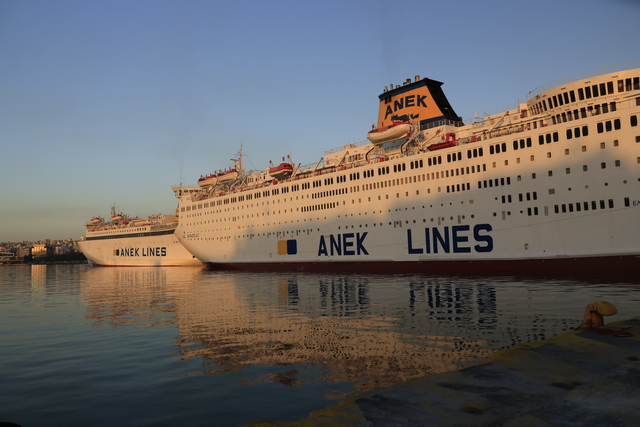









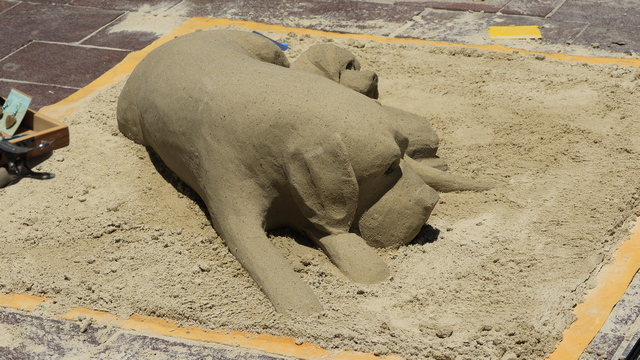


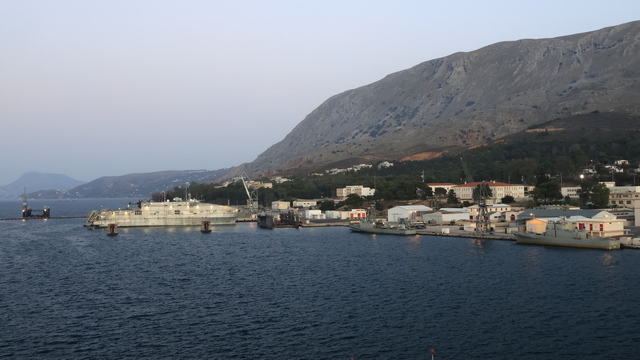






























































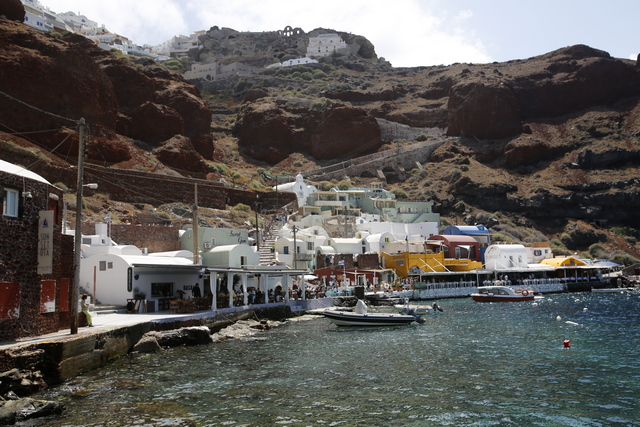

























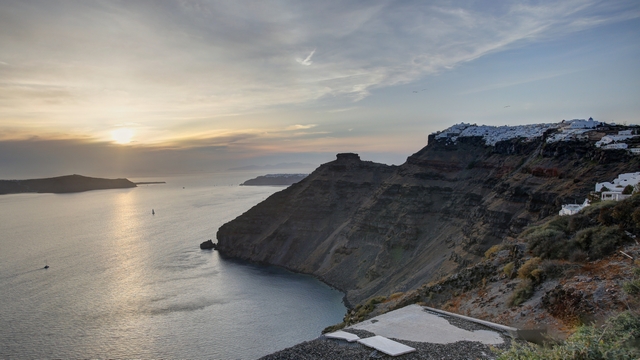




















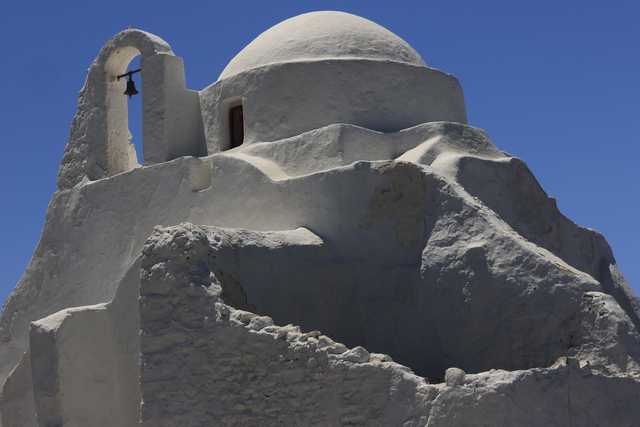



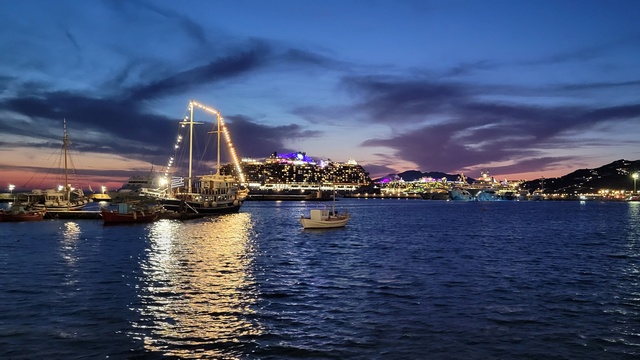















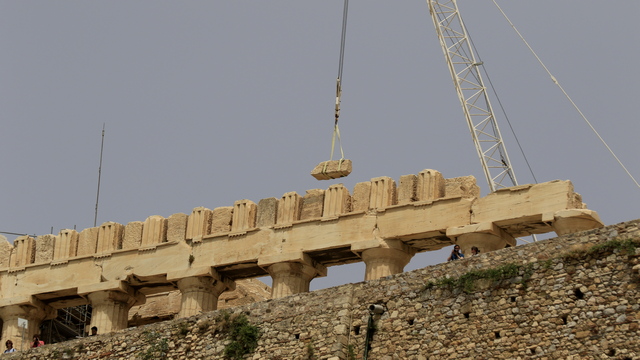
















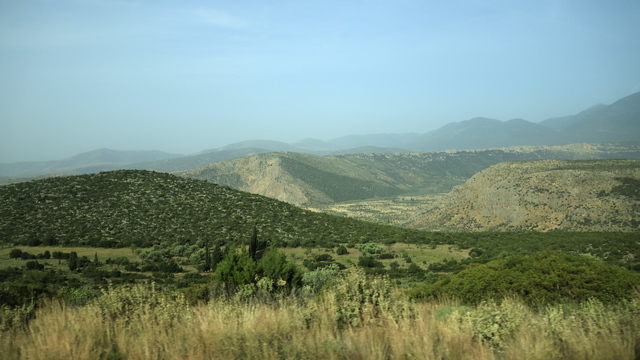


















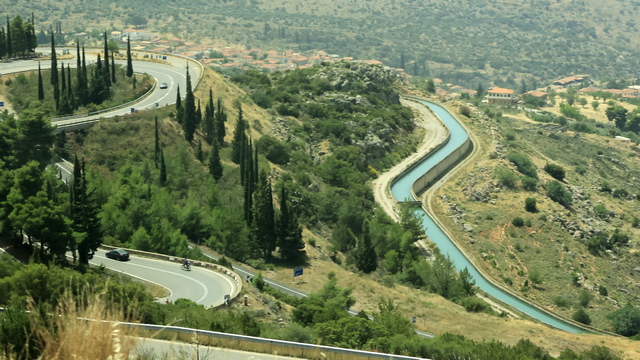








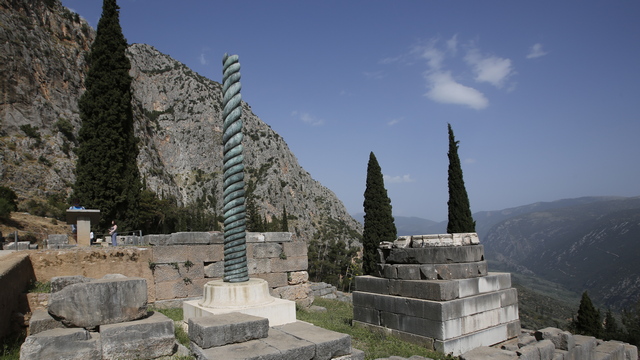






















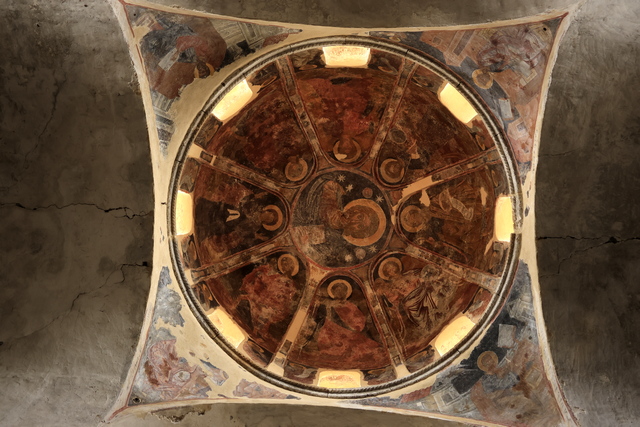



























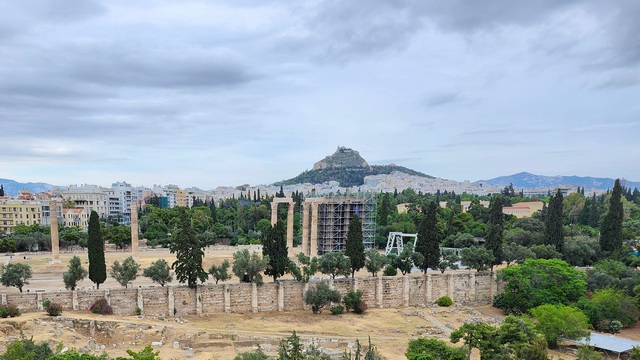
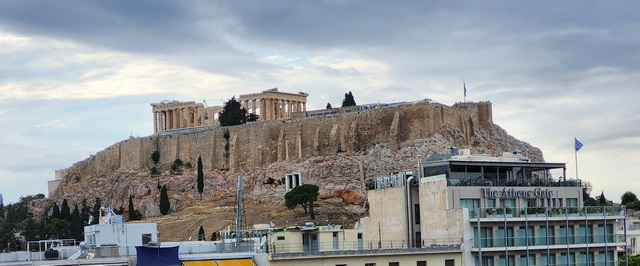




Comments